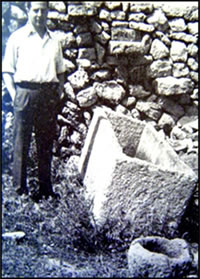RESEARCH > 1. Classic historical records
 Classic historical records Classic historical records
In the 18th century, the first studies about Menorca following a scientific and rigorous approach were written. In 1785, J. Ramis y Ramis suggested that the place-names Sanitja and Sanisera were very similar, when studying Pliny’s famous text, which was widely used by J. Vargas Ponce in his literary work. José Vargas joined the navy at the age of 23, becoming second lieutenant on a frigate with destination to the Astronomical Observatory in Cádiz. Once there, he was put in charge of a task consisting in designing the hydrographic charts of the Mediterranean coasts. In this journey he visited the Balearic Islands, where he collected a series of notes and pieces of information which were published by him in 1787, entitled “Descriptions of the Pithiusas and Balearic Islands”:
“Plinio que cuenta tres Ciudades [cartaginesas], no hace mension alguna de Labon, y sí nombra á Saniara de que ninguno otro hace mención (...). En el término de Mercadal al S. hay una bahía muy grande que llaman Sanitja, cuyo nombre se parece bastante al de Sanicera, á que se añade que en el fondo de esta bahía se descubren algunas ruinas muy antiguas, que tal vez podrían ser de la expresada Ciudad.” (Vargas Ponce, J.; 1787, Descripciones de las Islas Pithiusas y Baleares, pp. 44).
The similarity between Sanitja and Sanisera was not only noticed by J. Ramis y Ramis, but also by other Menorcan scholars such as F. Oleo and Quadrado. Later on, in the 19th century the archduke Luis Salvador continued exposing the similarity shared by the two place names, and also thought about the possible identification of the ruins located at the port of Sanitja with the ruins of Sanisera1.
We have to wait until the beginning of the 20th century in order to find more references to the location of Sanisera. In 1927, J. Cotrina2 thought that there was an old Roman settlement in the port of Sanitja.
In 1974, A. Garcia Bellido, in his notes on Pomponius Mela and Caius Plinius’ texts referring to Hispania, exposed that “Sanisera es desconocida” 3 and considered that, just like Schulten4, its location was somewhere nearby the town of Alaior.
A little bit later, A. M. Muñoz, in the analysis that he undertook about Latin and Greek written sources concerning to the Balearic Islands, commented that, with reference to the text by Pliny, “Sanisera no tenemos datos ni de momento su ubicación”5.
(1) "“La gran mella costera, donde se ubicara al parecer la antigua Sanisera, de la que podían apreciarse aún hasta hace poco sus viejos restos hoy englobados en la negra y voluminosa falda de la torre” (Austria, L. La isla de Menorca, p. 42- 43).
(2) Cotrina, J. Sobre las ruinas de Sanitja, Revista de Menorca, p. 83- 86.
(3) Garcia Bellido, A. La España del siglo I de nuestra era (según P. Mela y C. Plinio), p.245.
(4) Tovar. Iberische Landeskunden, p. 276.
(5) Muñoz, A. “ Fuentes escritas griegas y romanas sobre las Baleares” la Prehistoria y Arqueología de las Islas Baleares, p. 23.
|



